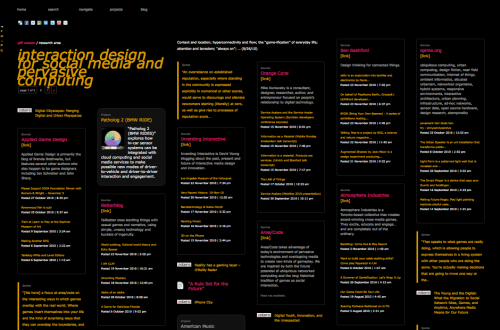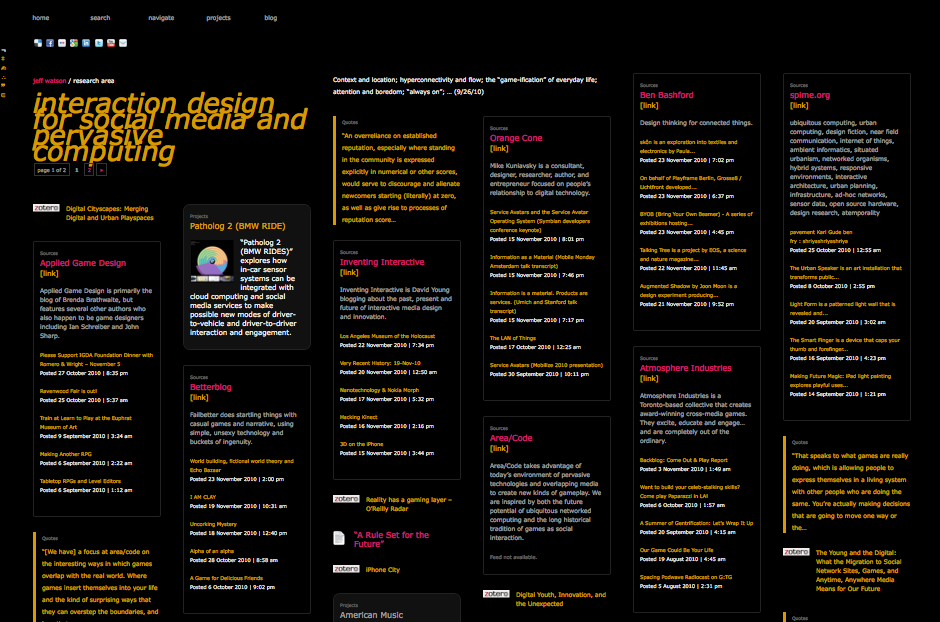This post is a part of a series covering my qualifying exam research areas. Scroll to the bottom of this post for links to each area, or click here for a general description of the process.
“It is better to live in a state of impermanence than in one of finality.” Gaston Bachelard, The Poetics of Space
Much of the early part of my qualifying exam preparation process was consumed with trying to come up with flexible-yet-precise titles for my exam areas. Since all knowledge is interconnected, this is always going to be a big challenge; but in the context of interdisciplinary new media theory and practice, I’m going to go out on a limb and say that it’s extra-super-hard to establish and maintain boundaries. Distinguishing between productive overlap (e.g. “History and Theories of Participatory Culture and Art Practice” is a powerful complement to “Interaction Design for Social Media and Pervasive Computing”) and outright redundancy (e.g. “The Poetics of Collaboration” would work as a subset of “History and Theories of Participatory Culture and Art Practice,” but would double-up on a lot of material if it were conceived of as a separate exam area) requires a whole lot of iteration and reshuffling. Some texts that began in one exam area are now comfortably in the middle of another. Because of the inherent either/or nature of the exam area structure (“text A is either in research area X, or it isn’t”), I found that some texts that were relevant to two or three of my research areas were being arbitrarily forced to exist in just one. What I really longed for was a non-hierarchical relational database that would provide an interface to my research alongside the more traditional “three exam areas” approach. Such a database would evolve as my own thoughts evolve. Like the impermanent, always-ahead-of-us dream space proposed by Bachelard, such an information architecture’s dynamism and impermanence would have the capacity to energize and liberate the imagination through serendipitous connection and unexpected emergence.

This website (https://remotedevice.net) is an effort to model what something like that might look like. Using WordPress, I’ve set up custom taxonomies for each of my three research areas into which I can place “research artifacts” — reading notes and summaries, quotes, links to resources and RSS feeds from relevant sources, blog posts, tweets, etc. These artifacts can then be tagged with keywords, categorized, and discovered through sitewide searches, allowing them to be accessed from vectors beyond the tight ontological constraints provided by the exam areas alone. The goal is that this will make visible and usable (to me and to anyone curious about my work) the connections between materials across the totality of my research.
As of right now, I’ve got a pretty substantial backlog of stuff to integrate into this system (doing so is the main work ahead of me as I review and collate and reflect upon the material I’ve generated over the past few months), but curious readers can peruse my exam area archives as they evolve by clicking on the “blog archives” links below.
Qualifying Exam Areas
- New media spaces [blog archive]
- History and theories of participatory culture and art practice [blog archive]
- Interaction design for social media and pervasive computing [blog archive]
You can also download the latest version of my exam area descriptions and bibliographies in .pdf form here.
